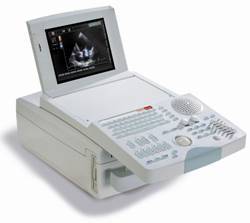Medical Ultrasound Imaging
Wednesday, 8 May 2024
Ultrasound Database •
A C-scan ultrasound can be displayed in 2D or 3D ultrasound technique. C-scan systems can generate images which are parallel to the surface of the skin (coronal). 2D plane images, usually in gray scale, are recordable at different depths, maintaining high quality subsurface information.
Further Reading: Basics:
News & More:
•
Cardiac ultrasound, also known as echocardiography or echocardiogram, is used to provide several different levels and types of heart testing. Cardiac ultrasound utilizes the same ultrasound principles as used for obstetric and gynecologic evaluations of pregnant women, gallbladder ultrasound and other abdominal structures. The ultrasound is directed out of a hand held probe which can be moved to image the heart from different positions. Additionally, so that heart events can be timed, ECG leads are placed on the chest. The reflected wave is converted into an actual image of the heart and displayed in a real-time mode or M-mode ultrasound format. M-mode recordings permit measurement of cardiac dimensions and detailed analysis of complex motion patterns depending on transducer angulations. Also the time relationships with other physiological variables such as ECG, heart sounds, and pulse tracings, can be recorded simultaneously. A stress echocardiogram provides information about the cardiac performance. Two-dimensional tomographic images of selected cardiac sections give more information than M-mode about the shape of the heart and also show the spatial relationships of its structures during the cardiac cycle (diastole to systole). See also M-Mode Echocardiography, and Myocardial Contrast Echocardiography. • View NEWS results for 'Cardiac Ultrasound' (15). Further Reading: News & More:
•
[This entry is marked for removal.] From POINT Biomedical Corp CARDIOsphere® is an ultrasound contrast agent for assessment of myocardial perfusion in patients with coronary artery disease composed of highly echogenic bispheres. PB127 is a new developed microbubble with a bilayer polymer/albumin shell filled with nitrogen gas that has ideal characteristics for power harmonic Doppler. They can be destroyed by high power ultrasound, and spectral decorrelation between ultrasound pulses is maximized by rapid dissolution of the released nitrogen gas. POINT Biomedical Corp. announced (March 01, 2004) that it has completed two Phase 3 trials of CARDIOsphere®. The Phase 3 trials were designed to evaluate the performance of CARDIOsphere® imaging relative to radionuclide imaging for detecting obstructive coronary artery disease and identifying the anatomic location of perfusion defects.
Drug Information and Specification
RESEARCH NAME
PB 127
DEVELOPER
INDICATION -
DEVELOPMENT STAGE Myocardial perfusion -
Phase 3 completed APPLICATION
Infusion
TYPE
Microbubble
Polylactide/Albumin
CHARGE
Slight Negative
Nitrogen
PREPARATION
Reconstitute with 2ml H2O per vial and dilute with 150 ml DSW
DO NOT RELY ON THE INFORMATION PROVIDED HERE, THEY ARE
NOT A SUBSTITUTE FOR THE ACCOMPANYING PACKAGE INSERT! •  From Biosound Esaote, Inc.;
From Biosound Esaote, Inc.;'Portable. Caris is a high performance ultrasound system that can go where you need it. Weighing less than 35 pounds, and with a built-in carrying handle, Caris Plus can be adapted to almost any clinical environment.' Specifications for this system will be available soon. •
Cavitation is any activity of highly compressible transient or stable microbubbles of gas and/or vapour, generated by ultrasonic power in the propagation medium. Cavitation can be described as inertial or non-inertial. Inertial cavitation has the most potential to damage tissue and occurs when a gas-filled cavity grows, during pressure rarefaction of the ultrasound pulse, and contracts, during the compression phase. Collapses of bubbles can generate local high temperatures and pressures. Transient cavitation can cause tissue damage.
The threshold for cavitation is high and does not occur at current levels of diagnostic ultrasound. The introduction of contrast agents leads to the formation of microbubbles that potentially provide gas nuclei for cavitation. The use of contrast agents can lower the threshold at which cavitation occurs. Types of cavitation:
•
Stable cavitation - steady microbubble oscillation due to the passage of a sound wave.
|
Medical-Ultrasound-Imaging.com
former US-TIP.com
Member of SoftWays' Medical Imaging Group - MR-TIP • Radiology TIP • Medical-Ultrasound-Imaging
Copyright © 2008 - 2024 SoftWays. All rights reserved.
Terms of Use | Privacy Policy | Advertise With Us
former US-TIP.com
Member of SoftWays' Medical Imaging Group - MR-TIP • Radiology TIP • Medical-Ultrasound-Imaging
Copyright © 2008 - 2024 SoftWays. All rights reserved.
Terms of Use | Privacy Policy | Advertise With Us
[last update: 2023-11-06 01:42:00]




